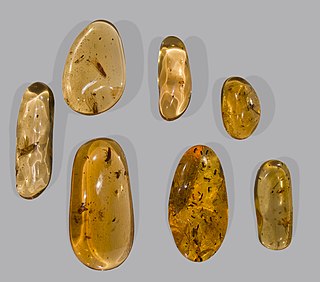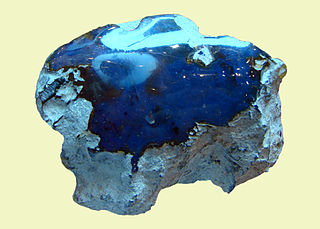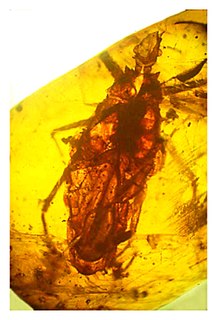
Amber is fossilized tree resin that has been appreciated for its color and natural beauty since Neolithic times. Much valued from antiquity to the present as a gemstone, amber is made into a variety of decorative objects. Amber is used in jewelry. It has also been used as a healing agent in folk medicine.

Copal is a name given to tree resin, particularly the aromatic resins from the copal tree Protium copal (Burseraceae) used by the cultures of pre-Columbian Mesoamerica as ceremonially burned incense and for other purposes. More generally, the term copal describes resinous substances in an intermediate stage of polymerization and hardening between "gummier" resins and amber.
George O. Poinar Jr. is an American entomologist and writer. He is known for popularizing the idea of extracting DNA from insects fossilized in amber, an idea which received widespread attention when adapted by Michael Crichton for the book and movie Jurassic Park.

Blue amber is a rare variety of amber resin that exhibits a blue coloration. Blue amber has been found only in the Dominican Republic—especially in the amber mines around the city of Santiago and, less commonly, in the eastern half of the country. In the modern age, it was discovered at about the same time as Dominican amber.

Dominican amber is amber from the Dominican Republic derived from resin of the extinct tree Hymenaea protera.

Hymenaea L. is a genus in the flowering plant family Fabaceae. Of fourteen living species in the genus, all but one are native to the tropics of the Americas, with one additional species on the east coast of Africa. Some authors place the African species in a separate monotypic genus, Trachylobium. In the Neotropics, Hymenaea is distributed through the Caribbean islands, and from southern Mexico to Brazil. Linnaeus named the genus in 1753 in Species Plantarum for Hymenaios, the Greek god of marriage ceremonies. The name is a reference to the paired leaflets.

Triatoma dominicana is an extinct species of assassin bug in the subfamily Triatominae, the kissing bugs known from early Miocene Burdigalian stage Dominican amber deposits on the island of Hispaniola.
Voltinia dramba is a fossil metalmark butterfly, found in pieces of amber in the Dominican Republic on the island of Hispaniola in 2004. The butterfly, belonging to the extant genus Voltinia, is the first species to be taxonomically described from amber and the first true fossil of an adult riodinid. Five specimens, all females, were found in pieces of amber from the resin of the extinct leguminous tree Hymenaea protera. Also, the genus Voltinia contains nine heterogeneous species that range from Mexico to Brazil. The fossil appeared to be 15-25 million years old and it's a holotype female fossil. However, the fossil's origin may be unknown, it is ingrained in highly polymerized Dominican amber.
Syndesus ambericus is an extinct species of stag beetles in the subfamily Syndesinae known from a single possibly Miocene fossil found on Hispaniola. S. ambericus is the first species of stag beetle to have been described from fossils found in Dominican amber and is one of four species from amber, and the only stag beetle species known from the Caribbean.
Anthophorula (Anthophorula) persephone is an extinct species of bee in the subfamily Apinae known from a pair of possibly Miocene fossils found on Hispaniola. A. persephone is the first species of the bee tribe Exomalopsini to have been described from fossils found in Dominican amber and is the only species of Anthophorula found in the West Indies.
Hymenaea allendis is an extinct legume species in the family Fabaceae described from a single isolated fossil flower in amber. The species is known from a Late Oligocene to Early Miocene location in southern Mexico. Unlike the coeval extinct species Hymenaea mexicana and Hymenaea protera which are placed closer to the living species Hymenaea verrucosum of Africa, H. allendis is closer in relation to the neotropical species of Hymenaea.
Acanthognathus poinari is an extinct species of ant in the subfamily Myrmicinae known from a single possibly Miocene fossil found on Hispaniola. A. poinari is the first species of the ant genus Acanthognathus to have been described from fossils found in Dominican amber and is one of several species of Acanthognathus found in the Greater Antillies.

The La Toca Formation is a geologic formation in the northern and eastern part of the Dominican Republic. The formation, predominantly an alternating sequence of marls and turbiditic sandstones, breccias and conglomerates, is renowned for the preservation of insects and other arthropods in amber, known as Dominican amber. The formation is dated to the Burdigalian to Langhian stages of the Miocene period.
Apterostigma electropilosum is an extinct species of ant in the subfamily Myrmicinae known from a single possibly Miocene fossil found on Hispaniola. A. electropilosum is one of only two species of the ant genus Apterostigma and one of five attini species to have been described from fossils found in Dominican amber.

Formicodiplogaster is an extinct form genus of nematodes in the family Diplogasteridae which currently includes a single described species Formicodiplogaster myrmenema. The species is known from early Miocene fossils found on Hispaniola. F. myrmenema has been preserved in association with Azteca alpha, one of only two known fossil species in the ant genus Azteca.
Azteca eumeces is an extinct species of ant in the subfamily Dolichoderinae known from possibly Miocene fossils found on Hispaniola. A. eumeces is one of only two species in the ant genus Azteca to have been described from fossils, both found in Dominican amber.

Mexican amber, also known as Chiapas Amber is amber found in Mexico, created during the late Oligocene and Early Miocene epochs of the Cenozoic Era in southwestern North America. As with other ambers, a wide variety of taxa have been found as inclusions including insects and other arthropods, as well as plant fragments and epiphyllous fungi.

Palaeoplethodon hispaniolae is an extinct salamander species found in Miocene Dominican amber from the Dominican Republic. It is so far the only salamander species known to have existed in the Caribbean.
Japanese amber - Japanese amber is a type of amber that can be found in the north of Japan, near the Pacific Ocean.












